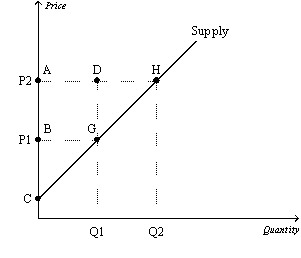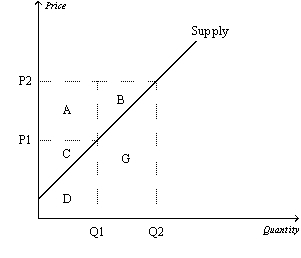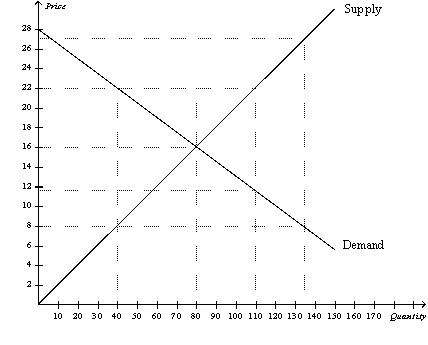A) total benefit.
B) producer surplus.
C) consumer surplus.
D) None of the above is correct.
F) C) and D)
Correct Answer

verified
Correct Answer
verified
Multiple Choice
Figure 7-7  -Refer to Figure 7-7.Which area represents the increase in producer surplus when the price rises from P1 to P2 due to new producers entering the market?
-Refer to Figure 7-7.Which area represents the increase in producer surplus when the price rises from P1 to P2 due to new producers entering the market?
A) BCG
B) ACH
C) DGH
D) AHGB
F) B) and C)
Correct Answer

verified
Correct Answer
verified
Multiple Choice
Figure 7-11  -Refer to Figure 7-11.Area A represents
-Refer to Figure 7-11.Area A represents
A) producer surplus to new producers entering the market as the result of an increase in price from P1 to P2.
B) the increase in consumer surplus that results from an upward-sloping supply curve.
C) the increase in total surplus when sellers are willing and able to increase supply from Q1 to Q2.
D) the increase in producer surplus to those producers already in the market when the price increases from P1 to P2.
F) B) and C)
Correct Answer

verified
Correct Answer
verified
Multiple Choice
Total surplus in a market will increase when the government
A) imposes a tax on that market.
B) imposes a binding price floor on that market.
C) removes a binding price ceiling from that market.
D) None of the above is correct.
F) A) and C)
Correct Answer

verified
Correct Answer
verified
Multiple Choice
Kelly is willing to pay $68 for a pair of shoes for a wedding.She finds a pair at her favorite outlet shoe store for $48.Kelly's consumer surplus is
A) $10.
B) $20.
C) $48.
D) $68.
F) B) and C)
Correct Answer

verified
Correct Answer
verified
Multiple Choice
Josh is willing to pay $40 for a haircut,but he is able to pay $25 at the local salon.His consumer surplus is
A) $0 because the cost exceeds his maximum willingness to pay.
B) $15.
C) $25.
D) $65.
F) B) and C)
Correct Answer

verified
Correct Answer
verified
Multiple Choice
On a graph,consumer surplus is represented by the area
A) between the demand and supply curves.
B) below the demand curve and above price.
C) below the price and above the supply curve.
D) below the demand curve and to the right of equilibrium price.
F) A) and D)
Correct Answer

verified
Correct Answer
verified
True/False
When demand increases so that market price increases,producer surplus increases because (1)producer surplus received by existing sellers increases,and (2)new sellers enter the market.
B) False
Correct Answer

verified
Correct Answer
verified
Multiple Choice
Which of the following is not true when the price of a good or service falls?
A) Buyers who were already buying the good or service are better off.
B) Some new buyers,who are now willing to buy,enter the market.
C) The total consumer surplus in the market increases.
D) The total value of purchases before and after the price change is the same.
F) B) and C)
Correct Answer

verified
Correct Answer
verified
Multiple Choice
Producer surplus directly measures
A) the well-being of sellers.
B) production costs.
C) excess demand.
D) unsold inventories.
F) A) and C)
Correct Answer

verified
Correct Answer
verified
Multiple Choice
Figure 7-15  -Refer to Figure 7-15.Assume demand increases and as a result,equilibrium price increases to $22 and equilibrium quantity increases to 110.The increase in producer surplus due to new producers entering the market would be
-Refer to Figure 7-15.Assume demand increases and as a result,equilibrium price increases to $22 and equilibrium quantity increases to 110.The increase in producer surplus due to new producers entering the market would be
A) $90.
B) $210.
C) $360.
D) $480.
F) A) and C)
Correct Answer

verified
Correct Answer
verified
Multiple Choice
Anita sharpens knives in her spare time for extra income.Buyers of her service are willing to pay $3.50 per knife for as many knives as Anita is willing to sharpen.On a particular day,she is willing to sharpen the first knife for $2.00,the second knife for $2.50,the third knife for $3.00,and the fourth knife for $3.50.Assume Anita is rational in deciding how many knives to sharpen.Her producer surplus is
A) $3.50.
B) $3.00.
C) $2.00.
D) $0.50.
F) C) and D)
Correct Answer

verified
Correct Answer
verified
Multiple Choice
Table 7-7
The only four producers in a market have the following cost:
 -Refer to Table 7-7.If Charlie,Quinn,and Wrex sell the good,and the resulting producer surplus is $300,then the price must have been
-Refer to Table 7-7.If Charlie,Quinn,and Wrex sell the good,and the resulting producer surplus is $300,then the price must have been
A) $200.
B) $300.
C) $450.
D) $600.
F) A) and B)
Correct Answer

verified
Correct Answer
verified
Multiple Choice
Suppose the market demand curve for a good passes through the point (quantity demanded = 100,price = $25) .If there are five buyers in the market,then
A) the marginal buyer's willingness to pay for the 100th unit of the good is $25.
B) the sum of the five buyers' willingness to pay for the 100th unit of the good is $25.
C) the average of the five buyers' willingness to pay for the 100th unit of the good is $25.
D) all of the five buyers are willing to pay at least $25 for the 100th unit of the good.
F) A) and D)
Correct Answer

verified
Correct Answer
verified
Multiple Choice
Which of the Ten Principles of Economics does welfare economics explain more fully?
A) The cost of something is what you give up to get it.
B) Markets are usually a good way to organize economic activity.
C) Trade can make everyone better off.
D) A country's standard of living depends on its ability to produce goods and services.
F) B) and C)
Correct Answer

verified
Correct Answer
verified
True/False
Free markets allocate (a)the supply of goods to the buyers who value them most highly and (b)the demand for goods to the sellers who can produce them at least cost.
B) False
Correct Answer

verified
Correct Answer
verified
Multiple Choice
If a consumer places a value of $15 on a particular good and if the price of the good is $17,then the
A) consumer has consumer surplus of $2 if he or she buys the good.
B) consumer does not purchase the good.
C) market is not a competitive market.
D) price of the good will fall due to market forces.
F) A) and C)
Correct Answer

verified
Correct Answer
verified
Multiple Choice
If an allocation of resources is efficient,then
A) consumer surplus is maximized.
B) producer surplus is maximized.
C) all potential gains from trade among buyers are sellers are being realized.
D) the allocation achieves equality as well.
F) B) and C)
Correct Answer

verified
Correct Answer
verified
Multiple Choice
Inefficiency exists in an economy when a good is
A) being produced with less than all available resources.
B) not distributed fairly among buyers.
C) not being produced by the lowest-cost producers.
D) being consumed by buyers who value it most highly.
F) B) and C)
Correct Answer

verified
Correct Answer
verified
Multiple Choice
Total surplus is equal to
A) value to buyers - profit to sellers.
B) value to buyers - cost to sellers.
C) consumer surplus x producer surplus.
D) (consumer surplus + producer surplus) x equilibrium quantity.
F) All of the above
Correct Answer

verified
Correct Answer
verified
Showing 101 - 120 of 363
Related Exams